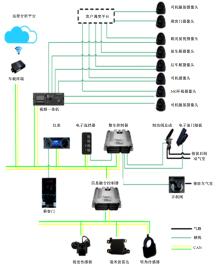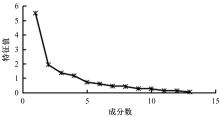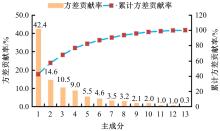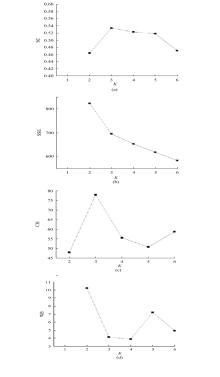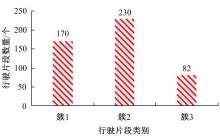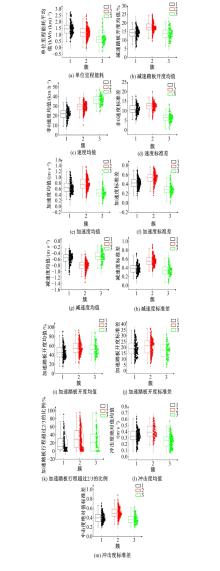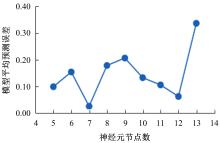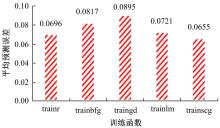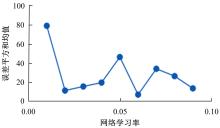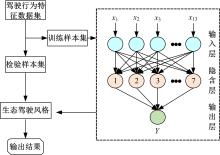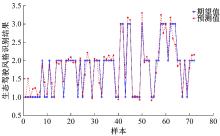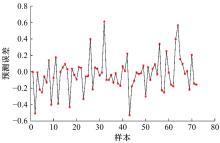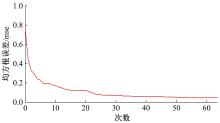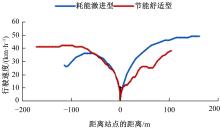吉林大学学报(工学版) ›› 2023, Vol. 53 ›› Issue (7): 2029-2042.doi: 10.13229/j.cnki.jdxbgxb.20211000
• 交通运输工程·土木工程 • 上一篇
考虑能耗的进出站驾驶风格分类及识别模型
- 长安大学 汽车学院,西安 710064
Classification and recognition model of entering and leaving stops' driving style considering energy consumption
Ya-li ZHANG( ),Rui FU,Wei YUAN(
),Rui FU,Wei YUAN( ),Ying-shi GUO
),Ying-shi GUO
- School of Automobile,Chang'an University,Xi'an 710064,China
摘要:
为实现对进出站驾驶风格的分类与识别,基于纯电动公交车自然驾驶过程中的进出站片段数据,选取14个驾驶行为表征指标,利用主成分分析法对指标降维,建立K-means聚类模型将进出站片段聚为3类;以经济性、动力性和舒适性为语义解释的3个维度,对3类群集语义解释为耗能激进型、一般型和节能舒适型;建立三层BP神经网络模型,实现进出站驾驶风格的在线识别。模型验证发现,识别模型各评价指标值均处于0附近,且模型平均识别率为93.52%,可以较好地实现对任意进出站片段的驾驶风格识别。
中图分类号:
- U121
| 1 | Wang Wen-shuo, Xi Jun-qiang, Liu Chang, et al. Human-centered feed-forward control of a vehicle steering system based on a driver's path-following characteristics[J]. IEEE Transactions on Intelligent Transportation Systems, 2017, 18(6):1440-1453. |
| 2 | Martinez C M, Heucke M, Wang Fei-yue, et al. Driving style recognition for intelligent vehicle control and advanced driver assistance: a survey[J]. IEEE Transactions on Intelligent Transportation Systems, 2018, 19(3): 666-676. |
| 3 | Dib W, Chasse A, Moulin P, et al. Optimal energy management for an electric vehicle in eco-driving application[J]. Control Engineering Practice, 2014, 29(8): 299-307. |
| 4 | Javanmardi S, Bideaux E, Trégouët J, et al. Driving style modelling for eco-driving applications[J]. IFAC-Papers OnLine, 2017, 50(1): 13866-13871. |
| 5 | Butakov V, Ioannou P. Personalized driver/vehicle lane change models for ADAS[J]. IEEE Transactions on Vehicular Technology, 2015, 64(10): 4422-4431. |
| 6 | Higgs B, Abbas M. Segmentation and clustering of car-following behavior: recognition of driving patterns[J]. IEEE Transactions on Intelligent Transportation Systems, 2015, 16(1): 81-90. |
| 7 | Mohammadnazar A, Arvin R, Khattak A J. Classifying travelers' driving style using basic safety messages generated by connected vehicles: application of unsupervised machine learning[J]. Transportation Research Part C: Emerging Technologies, 2021, 122:102917. |
| 8 | Forster D, Inderka R B, Gauterin F. Data-driven identification of characteristic real-driving cycles based on k-means clustering and mixed-integer optimization[J]. IEEE Transactions on Vehicular Technology, 2019, 69(3): 2398-2410. |
| 9 | Wang W S, Xi J Q, Chong A, et al. Driving style classification using a semisupervised support vector machine[J]. IEEE Transactions on Human Machine Systems, 2017, 47(5): 650-660. |
| 10 | Han Wei, Wang Wen-Shuo, Li Xiao-Han, et al. Statistical-based approach for driving style recognition using bayesian probability with kernel density estimation[J]. IET Intelligent Transport Systems, 2018, 13(1): 22-30. |
| 11 | Wang Wen-Shuo, Xi Jun-Qiang, Zhao Ding. Driving style analysis using primitive driving patterns with bayesian nonparametric approaches[J]. IEEE Transactions on Intelligent Transportation Systems, 2018,20(8): 2986-2998. |
| 12 | 严英. 纯电动公交客车加速踏板驾驶特性辅助优化策略研究[D].天津:天津大学机械工程学院, 2012. |
| Yan Ying. Study on the driving assistant of accleration pedal for the pure electric bus[D]. Tianjin: School of Mechanical Engineering, Tianjin University, 2012. | |
| 13 | 叶玉.西方国家力推“生态驾驶”[J].环境与保护,2008,403(9):73-74. |
| Ye Yu. Western countries push "eco-driving"[J]. Environmental Protection,2008,403(9):73-74. | |
| 14 | 朱嘉欣, 包雨恬, 黎朝. 数据离群值的检验及处理方法讨论[J]. 大学化学, 2018, 33(8): 58-65. |
| Zhu Jia-xin, Bao Yu-tian, Li Zhao. Discussion on the method for testing and treating outliers[J]. University Chemistry, 2018, 33(8): 58-65. | |
| 15 | Meenpal T, Goyal A, Meenpal A. Face recognition system based on principal components analysis and distance measures[J]. International Journal of Engineering Technologies IJET, 2021, 7(2): 15-19. |
| 16 | 吴丽宁. 基于驾驶风格分类的卡车油耗预测[D].西安:长安大学信息工程学院,2020. |
| Wu Li-ning. Truck fuel consumption prediction based on driving style classification[D]. Xi'an: School of Information Engineering, Chang'an Universty, 2020. | |
| 17 | Johnstone L M, Lu A Y. On consistency and sparsity for principal components analysis in high dimensions[J]. Journal of the American Statistical Association, 2009, 104(486): 682-693. |
| 18 | Clayman C L, Srinivasan S M, Sangwan R S. K-means clustering and principal components analysis of microarray data of L1000 landmark genes[J]. Procedia Computer Science, 2020, 168:97-104. |
| 19 | Fu Rui, Liu Tong, Guo Ying-shi, et al. A case study in china to determine whether gps data and derivative indicator can be used to identify risky drivers[J]. Journal of Advanced Transportation, 2019, 2019:1-16. |
| 20 | Hidayati R, Zubair A, Pratama A H, et al. Analisis silhouette coefficient pada 6 perhitungan jarak k-means clustering[J]. Techno Com, 2021, 20(2): 186-197. |
| 21 | Yang Wen-kang, Du Qiao-ling, Cui Jian-chao, et al. Motion recognition based on sum of the squared errors distribution[J]. IEEE Access, 2021, 9: 37116-37130. |
| 22 | Lima S P, Cruz M. A genetic algorithm using calinski-harabasz index for automatic clustering problem[J]. Revista Brasileira de Computação Aplicada, 2020, 12(3): 97-106. |
| 23 | Wang Yi-mei, Liu Yong-qian, Li Li, et al. Short-term wind power forecasting based on clustering pre-calculated CFD method[J]. Energies, 2018, 11(4): No.854. |
| 24 | 余涛. 基于SVM和BP神经网络的短时交通流预测与实现[D]. 南京:南京邮电大学现代邮政学院, 2018. |
| Yu Tao. Prediction and implementation of short-term traffic based on the combination model of SVM and BP neural networks[D]. Nanjing: School of Modern Posts, Nanjing University of Posts and Telecommunications, 2018. | |
| 25 | 孙宝磊,孙暠,张朝能,等.基于BP神经网络的大气污染物浓度预测[J].环境科学学报,2017,37(5):1864-1871. |
| Sun Bao-lei, Sun Hao, Zhang Chao-neng, et al. Forecast of air pollutant concentrations by BP neutual network[J]. Acta Scientiae Circumstantiae, 2017,37(5):1864-1871. | |
| 26 | 伍毅平. 生态驾驶行为特征甄别及反馈优化方法研究[D].北京:北京工业大学城市建设学部,2017. |
| Wu Yi-ping. Research on eco-driving behavior characteristics identification and feedback optimization method[D]. Bejing: Faculty of Architecture, Civil and Transportation Engineering, Beijing University of Technology, 2017. |
| [1] | 马壮林,崔姗姗,胡大伟,王晋. 限行政策下传统小汽车出行者出行方式选择[J]. 吉林大学学报(工学版), 2023, 53(7): 1981-1993. |
| [2] | 尹超英,陆颖,邵春福,马健霄,许得杰. 考虑空间自相关的建成环境对通勤方式选择的影响[J]. 吉林大学学报(工学版), 2023, 53(7): 1994-2000. |
| [3] | 宋灿灿,荆迪菲,谢俊峰,康可心. 设置广告牌的高速公路平曲线路段驾驶行为分析[J]. 吉林大学学报(工学版), 2023, 53(5): 1345-1354. |
| [4] | 潘恒彦,王永岗,李德林,陈俊先,宋杰,杨钰泉. 基于交通冲突的长纵坡路段追尾风险评估及预测[J]. 吉林大学学报(工学版), 2023, 53(5): 1355-1363. |
| [5] | 康耀龙,冯丽露,张景安,曹素娥. 基于谱聚类的不确定数据集中快速离群点挖掘算法[J]. 吉林大学学报(工学版), 2023, 53(4): 1181-1186. |
| [6] | 姚荣涵,徐文韬,郭伟伟. 基于因子长短期记忆的驾驶人接管行为及意图识别[J]. 吉林大学学报(工学版), 2023, 53(3): 758-771. |
| [7] | 卢凯,徐广辉,叶志宏,林永杰. 考虑清空时间的双向队首绿波协调控制数解算法[J]. 吉林大学学报(工学版), 2023, 53(2): 421-429. |
| [8] | 曲福恒,钱超越,杨勇,陆洋,宋剑飞,胡雅婷. 基于多球分裂的增量式k-means聚类算法[J]. 吉林大学学报(工学版), 2022, 52(6): 1434-1441. |
| [9] | 康耀龙,冯丽露,张景安,陈富. 基于谱聚类的高维类别属性数据流离群点挖掘算法[J]. 吉林大学学报(工学版), 2022, 52(6): 1422-1427. |
| [10] | 张鑫,张卫华. 快速路合流区主线不同交通状态下的安全性分析[J]. 吉林大学学报(工学版), 2022, 52(6): 1308-1314. |
| [11] | 纪少波,李洋,李萌,苏士斌,马晓龙,何绍清,贾国瑞,程勇. 纯电动共享汽车驾驶行为对能耗的影响[J]. 吉林大学学报(工学版), 2022, 52(4): 754-763. |
| [12] | 邢海燕,刘超,徐成,陈玉环,王松弘泽. 基于粒子群优化模糊C焊缝等级磁记忆定量识别模型[J]. 吉林大学学报(工学版), 2022, 52(3): 525-532. |
| [13] | 廖汉超,单汨源. 基于模糊聚类最大树算法的高层建筑基坑工程风险识别方法[J]. 吉林大学学报(工学版), 2022, 52(12): 2892-2897. |
| [14] | 曲大义,赵梓旭,贾彦峰,王韬,刘琼辉. 基于Lennard-Jones势的车辆跟驰动力学特性及模型[J]. 吉林大学学报(工学版), 2022, 52(11): 2549-2557. |
| [15] | 董春娇,董黛悦,诸葛承祥,甄理. 电动自行车出行特性及骑行决策行为建模[J]. 吉林大学学报(工学版), 2022, 52(11): 2618-2625. |
|
||
